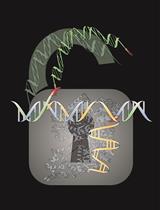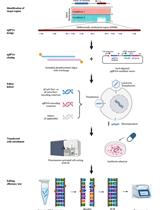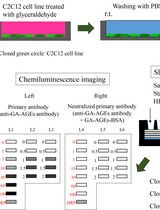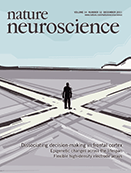- Submit a Protocol
- Receive Our Alerts
- Log in
- /
- Sign up
- My Bio Page
- Edit My Profile
- Change Password
- Log Out
- EN
- EN - English
- CN - 中文
- Protocols
- Articles and Issues
- For Authors
- About
- Become a Reviewer
- EN - English
- CN - 中文
- Home
- Protocols
- Articles and Issues
- For Authors
- About
- Become a Reviewer
5-Hydroxymethylcytosine (5-hmC) Specific Enrichment
Published: Vol 2, Iss 15, Aug 5, 2012 DOI: 10.21769/BioProtoc.242 Views: 10984

Protocol Collections
Comprehensive collections of detailed, peer-reviewed protocols focusing on specific topics
Related protocols

Efficient Large DNA Fragment Knock-in by Long dsDNA with 3′-Overhangs Mediated CRISPR Knock-in (LOCK) in Mammalian Cells
Wenjie Han [...] Jianqiang Bao
Oct 20, 2023 2703 Views

CRISPR/dCas9-Tet1-Mediated DNA Methylation Editing
Junming Qian and Shawn X. Liu
Apr 20, 2024 3921 Views

Slot Blot Analysis of Intracellular Glyceraldehyde-Derived Advanced Glycation End Products Using a Novel Lysis Buffer and Polyvinylidene Difluoride Membrane
Takanobu Takata [...] Togen Masauji
Jul 20, 2024 1808 Views
Abstract
5-Hydroxymethylcytosine (5-hmC) is a newly discovered DNA modification in mammalian genomes. This protocol is to be a highly efficient and selective chemical approach to label and capture 5-hmC, taking advantage of a bacteriophage enzyme that adds a glucose moiety to 5-hmC specifically, which could in turn be used for high-throughput mapping via next-generation sequencing.
Keywords: 5-hydroxymethylcytocineMaterials and Reagents
- Sodium chloride (NaCl) (Sigma-Aldrich, catalog number: S3014 )
- Ethylenediaminetetraacetic acid (EDTA) (Sigma-Aldrich, catalog number: E9884 )
- Trizma base (Tris) (Sigma-Aldrich, catalog number: T1503 )
- HEPES (GenScript USA, catalog number: C01621 )
- Magnesium chloride (MgCl2) (Sigma-Aldrich, catalog number: M8266 )
- Dimethyl sulfoxide (DMSO) (Thermo Fisher Scientific, catalog number: D128 )
- Tween-20 (Sigma-Aldrich, catalog number: P9416 )
- DBCO-S-S-PEG3-Biotin conjugate (Click Chemistry Tools, catalog number: A112P3 )
- 1,4-Dithiothreitol, ultrapure (DTT) (Roche Applied Science, catalog number: 3117006001 )
- Hydroxymethyl Collector (Active Motif, catalog number: 55013 )
- Wizard Genomic DNA Purification Kit (Promega Corporation, catalog number: A1120 )
- 10 kDa Amicon Ultra-0.5 ml Centrifugal Filters (EMD Millipore, catalog number: UFC501008 )
- QIAquick Nucleotide Removal Kit (QIAGEN, catalog number: 28304 )
- Micro Bio-Spin 6 Column (Bio-Rad Laboratories, catalog number: 732-6222 )
- Dynabeads MyOne Streptavidin C1 (Life Technologies, Invitrogen™, catalog number: 650-01 )
- Qiagen MinElute PCR Purification Kit (QIAGEN, catalog number: 28004 )
- UltraPure Agarose (Life Technologies, Invitrogen™, catalog number: 16500500 )
- β-glucosyltransferase (β-GT) (New England Biolabs)
- 10x β-GT reaction buffer (see Recipes)
- 2x binding and washing (B&W) buffer (see Recipes)
- TE (see Recipes)
Equipment
- Sonication device (Covaris)
- Desktop centrifuge
- Water bath (Thermo Fisher Scientific)
- Gel running apparatus (Bio-Rad Corporation)
- Nanodrop 1000 (Thermo Fisher Scientific)
- Labquake tube shaker (Barnstead/Thermolyne)
- Magnetic separation stand (Promega Corporation, catalog number: Z5342 )
- Qubit 2.0 Fluorometer (Life Technologies, Invitrogen™)
Procedure
- Fragment purified genomic DNA into short fragments depending on different genome-wide sequencing platforms (usually sonicated to 300 bp). Follow the manual from Covaris to set up the fragmentation program for 300 bp. DNA buffer for sonication can be TE (10 mM Tris pH 8.0, 1 mM EDTA), EB (10 mM Tris pH 8.5) or water.
- Verify the size distribution of the fragmented genomic DNA on 2% agarose gel using 100-bp DNA marker. Measure the DNA concentration after fragmentation using Nanodrop or by fluorometric quantification of dsDNA, ideal concentration should be higher than 600 ng/μl.
- Concentrate the DNA if necessary by 10 kDa Amicon Ultra-0.5 ml Centrifugal Filters or ethanol precipitation. Measure DNA concentration again after concentration using Nanodrop.
- Use appropriate starting DNA amounts and set up the reaction according to the following conditions (for brain tissue).
Component Volume Final Concentration Water _ μl 10x β-GT reaction buffer 2 μl 1x up to 10 μg genomic DNA _ μl up to 500 ng/μl UDP-6-N3-Glc (3 mM) 0.67 μl 100 μM β-GT (40 μM) 1 μl 2 μM Total volume 20 μl - Mix by pipetting and incubate in a 37 °C water bath for 1 h.
- Clean up the reaction with QIAquick Nucleotide Removal Kit, using 10 μg DNA per column. Elute with 30 μl water per column and combine.
- Dissolve 10 mg DBCO-S-S-PEG3-Biotin conjugate in 384 μl DMSO to make 30 mM stock solution and store at -80 °C. Dilute stock solution with DMSO to make 4.5 mM working solution and store at -20 °C. Stock solution is stable at -80 °C for years. Working solution is stable at -20 °C for 3 months.
- Add DBCO-S-S-PEG3-Biotin conjugate working solution in the eluted DNA solution from step 6) to a final concentration of 150 μM (i.e. 1 μl of working solution per 30 μl DNA solution).
- Mix by pipetting and incubate in a 37 °C water bath for 1 h.
- Clean up the reaction with QIAquick Nucleotide Removal Kit, using 10 μg DNA per column. Elute with at least 30 μl water per column and combine. The ideal combined elution volume is 100 μl, maximum volume is 150 μl.
- Measure DNA concentration using Nanodrop, calculate the DNA recovery.
- Wash 50 μl of Dynabeads MyOne Streptavidin C1 three times with 100 μl of 1x B&W buffer following its manual. Separate the beads with a magnetic stand and resuspend the beads in 100 μl of 2x B&W buffer.
- Save 10 ng DNA from step 11), add the rest (100 to 150 μl) to the resuspended beads from the previous step.
- Incubate for 15 min at room temperature with gentle rotation on a Labquake tube shaker.
- Separate the beads with a magnetic stand and wash the beads three times with 200 μl of 1x B&W buffer.
- Elute the DNA by incubating the beads in 50 μl freshly prepared 100 mM DTT. for 2 h at room temperature with gentle rotation on a Labquake tube shaker.
- Separate the beads with a magnetic stand. Aspirate the eluent and load to a Micro Bio-Spin 6 Column following its instruction to remove the DTT.
- Purify the eluted DNA from previous step by Qiagen MinElute PCR Purification Kit and elute DNA in 10 μl EB buffer. Quantify DNA using Qubit Fluorometer. The DNA is ready for downstream genome-wide sequencing library preparation.
Recipes
- 10x β-GT reaction buffer
500 mM HEPES (pH 7.9)
250 mM MgCl2 - 2x binding and washing (B&W) buffer
10 mM Tris (pH 7.5)
1 mM EDTA
2 M NaCl
0.02% Tween 20 - TE
10 mM (Tris pH 8.0)
1 mM EDTA
Acknowledgments
The protocol described here is adapted from one reported previously (Song et al., 2011).
References
- Song, C. X., Szulwach, K. E., Fu, Y., Dai, Q., Yi, C., Li, X., Li, Y., Chen, C. H., Zhang, W., Jian, X., Wang, J., Zhang, L., Looney, T. J., Zhang, B., Godley, L. A., Hicks, L. M., Lahn, B. T., Jin, P. and He, C. (2011). Selective chemical labeling reveals the genome-wide distribution of 5-hydroxymethylcytosine. Nat Biotechnol 29(1): 68-72.
Article Information
Copyright
© 2012 The Authors; exclusive licensee Bio-protocol LLC.
How to cite
Szulwach, K. E., Song, C., He, C. and Jin, P. (2012). 5-Hydroxymethylcytosine (5-hmC) Specific Enrichment. Bio-protocol 2(15): e242. DOI: 10.21769/BioProtoc.242.
Category
Molecular Biology > DNA > DNA modification
Biochemistry > Carbohydrate > Glucose
Do you have any questions about this protocol?
Post your question to gather feedback from the community. We will also invite the authors of this article to respond.
Share
Bluesky
X
Copy link








